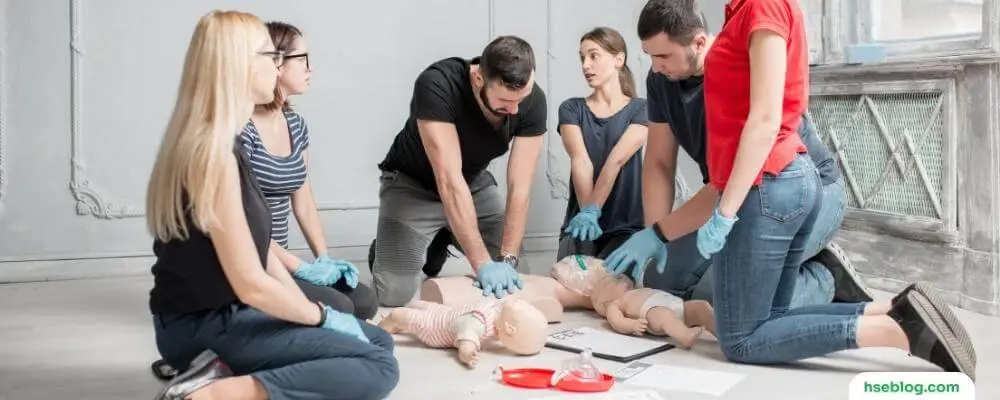Regarding first aid training, certain elements are essential for all programs. This blog post will discuss the key components of a successful first-aid training program. Understanding these elements allows you to create the right program for your business and employees!
First aid is emergency care provided for injury or sudden illness before emergency medical treatment is available. The first-aid provider in the workplace is trained in delivering initial medical emergency procedures, using a limited amount of equipment to perform a primary assessment and intervention while awaiting the arrival of emergency medical service (EMS) personnel.
A workplace first-aid program is part of comprehensive safety and health management system that includes the following four essential elements:
- Management Leadership and Employee Involvement
- Worksite Analysis
- Hazard Prevention and Control
- Safety and Health Training
Elements of a First Aid Training Program
There are several elements to include when planning a first-aid training program for a particular workplace. These recommendations are based on the best practices and evidence written in this guide. Statistical information is available from BLS to help assess the risks for specific types of work. Program elements to be considered are:
1. Teaching Methods
Training programs should incorporate the following principles:
Basing the curriculum on a consensus of scientific evidence where available;
- Having trainees develop “hands-on” skills through the use of mannequins and partner practice;
- Having appropriate first-aid supplies and equipment available;
- Exposing trainees to acute injury and illness settings as well as to the appropriate response through the use of visual aids;
- Including a course information resource for reference both during and after training;
- Allowing enough time for emphasis on commonly occurring situations;
- Emphasizing skills training and confidence-building over classroom lectures;
- Emphasizing quick response to first-aid situations.

2. Preparing to Respond to a Health Emergency
The training program should include instruction or discussion in the following:
- Prevention as a strategy for reducing fatalities, illnesses, and injuries;
- Interacting with the local EMS system;
- Maintaining a current list of emergency telephone numbers (police, fire, ambulance, poison control) accessible by all employees;
- Understanding the legal aspects of providing first-aid care, including Good Samaritan legislation, consent, abandonment, negligence, assault and battery, State laws and regulations;
- Understanding the effects of stress, fear of infection, and panic; how they interfere with performance; and what to do to overcome these barriers to action;
- Learning the importance of universal precautions and body substance isolation to provide protection from bloodborne pathogens and other potentially infectious materials. Learning about personal protective equipment — gloves, eye protection, masks, and respiratory barrier devices. Appropriate management and disposal of blood-contaminated sharps and surfaces; and awareness of OSHA’s Bloodborne Pathogens standard.
3. Assessing the Scene and the Victim(s)
The training program should include instruction in the following:
- Assessing the scene for safety, number of injured, and nature of the event;
- Assessing the toxic potential of the environment and the need for respiratory protection;
- Establishing the presence of a confined space and the need for respiratory protection and specialized training to perform a rescue;
- Prioritizing care when there are several injured;
- Assessing each victim for responsiveness, airway patency (blockage), breathing, circulation, and medical alert tags;
- Taking a victim’s history at the scene, including determining the mechanism of injury;
- Performing a logical head-to-toe check for injuries;
- Stressing the need to monitor the victim continuously;
- Emphasizing early activation of EMS;
- Indications for and methods of safely moving and rescuing victims;
- Repositioning ill/injured victims to prevent further injury.

4. Responding to Life-Threatening Emergencies
The training program should be designed or adapted for the specific worksite and may include first-aid instruction in the following:
- Establishing responsiveness;
- Establishing and maintaining an open and clear airway;
- Performing rescue breathing;
- Treating airway obstruction in a conscious victim;
- Performing CPR;
- Using an AED;
- Recognizing the signs and symptoms of shock and providing first aid for shock due to illness or injury;
- Assessing and treating a victim who has an unexplained change in the level of consciousness or sudden illness;
- Controlling bleeding with direct pressure;
- Poisoning Ingested poisons: alkali, acid, and systemic poisons. Role of the Poison Control Center (1-800-222-1222); Inhaled poisons: carbon monoxide; hydrogen sulfide; smoke; and other chemical fumes, vapors, and gases. Assessing the toxic potential of the environment and the need for respirators; Knowledge of the chemicals at the worksite and of first aid and treatment for inhalation or ingestion; Effects of alcohol and illicit drugs so that the first-aid provider can recognize the physiologic and behavioral effects of these substances.
- Recognizing asphyxiation and the danger of entering a confined space without appropriate respiratory protection. Additional training is required if first-aid personnel assist in the rescue from the confined space.
- Responding to Medical Emergencies Chest pain; Stroke; Breathing problems; Anaphylactic reaction; Hypoglycemia in diabetics taking insulin; Seizures; Pregnancy complications; Abdominal injury; Reduced level of consciousness; Impaled object.

5. Responding to non-life-threatening Emergencies
The training program should be designed for the specific worksite and include first-aid instruction for the management of the following:
Wounds
- Assessment and first aid for wounds, including abrasions, cuts, lacerations, punctures, avulsions, amputations, and crush injuries;
- Principles of wound care, including infection precautions;
- Principles of body substance isolation, universal precautions, and use of personal protective equipment.
Burns
- Assessing the severity of a burn;
- Recognizing whether a burn is thermal, electrical, or chemical and the appropriate first aid;
- Reviewing corrosive chemicals at a specific worksite, along with appropriate first aid.
Temperature Extremes
- Exposure to cold, including frostbite and hypothermia;
- Exposure to heat, including heat cramps, heat exhaustion, and heatstroke.
Musculoskeletal Injuries
- Fractures;
- Sprains, strains, contusions, and cramps;
- Head, neck, back, and spinal injuries;
- Appropriate handling of amputated body parts.
Eye injuries
- First aid for eye injuries;
- First aid for chemical burns
Mouth and Teeth Injuries
- Oral injuries; lip and tongue injuries; broken and missing teeth;
- The importance of preventing aspiration of blood and/or teeth.
Bites and Stings
- Human and animal bites;
- Bites and stings from insects; instruction in first-aid treatment of anaphylactic shock.

6. Trainee Assessment
Assessment of successful completion of the first-aid training program should include instructor observation of acquired skills and written performance assessments.
7. Skills Update
First-aid responders may have long intervals between learning CPR and AED skills. Numerous studies have shown a retention rate of 6-12 months for these critical skills. The American Heart Association’s Emergency Cardiovascular Care Committee encourages skills review and practice sessions for CPR and AED skills at least every six months. Instructor-led retraining for life-threatening emergencies should occur at least annually. Retraining for non-life-threatening responses should occur periodically.
8. Program Update
The first-aid program should be reviewed periodically to determine if it continues to address the needs of the specific workplace. Since the last program review, training, supplies, equipment, and first-aid policies should be added or modified to account for workplace safety, health hazard changes, worksite locations, and worker schedules. The first-aid training program should be up-to-date with current techniques and knowledge. Outdated training and reference materials should be replaced or removed.
Summary
Employers are required by OSHA standard 29 CFR 1910.151 to have a person or persons adequately trained to render first aid for worksites that are not near an infirmary, clinic, or hospital. It is advised that the first-aid program for a particular workplace be designed to reflect the known and anticipated risks of the specific work environment. Consultation with local emergency medical experts and providers of first-aid training is encouraged when developing a first-aid program.
The program must comply with all applicable OSHA standards and regulations. (See section on OSHA Requirements.) OSHA requires certain employers to have CPR-trained rescuers on site. Sudden cardiac arrest is a potential risk at all worksites, regardless of the type of work. Serious consideration should be given to establishing a workplace AED program. First-aid supplies must be available in adequate quantities and be readily accessible.
First-aid training courses should include general and workplace hazard-specific knowledge and skills instruction. CPR training should incorporate AED training if an AED is available at the worksite. First-aid training should be repeated periodically to maintain and update knowledge and skills. Management commitment and worker involvement are vital in developing, implementing, and assessing a workplace first-aid program.

